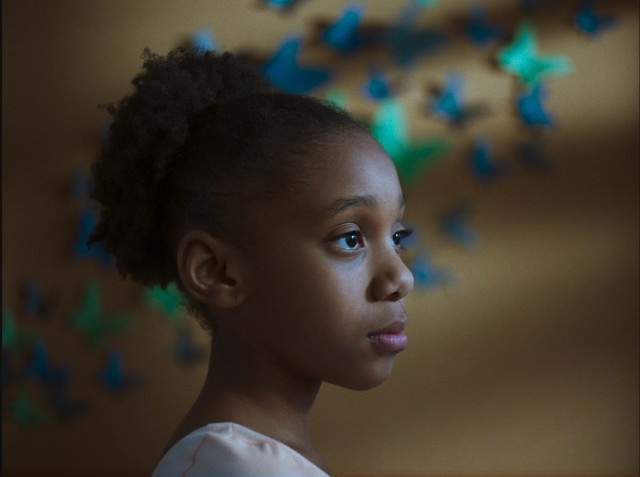With all the girls in her ballet class excited for an upcoming photoshoot Mahalia, the only black girl in the group, starts to feel self-conscious about her hair, so her mother sees this as the perfect opportunity to take her to a salon for the first time. In Mahalia Melts in the Rain co-directors Emilie Mannering and Carmine Pierre-Dufour use this simple scenario to create a double coming of age narrative, as we follow the short’s nine-year-old protagonist as she begins to notice how she is different to the other girls in the class (a predominantly white environment) and her mother takes her on a rite of passage experience.
“We wanted to examine the standards of beauty that are still being imposed on women in general and women of colour in particular”
Based on director and screenwriter Pierre-Dufour’s childhood memories, she recalls that the first time she got her hair straightened was for a ballet recital when she was six years old. Dance recitals can be an exciting time for young ballerinas, but it is undeniable that they can also trigger anxiety for those involved, with everyone expected to look a certain way and comparisons are bound to happen. Through this narrative, the directors shared with us that they aimed to “examine the standards of beauty that are still being imposed on women in general and women of colour in particular”. With such a young protagonist at the heart of their story, they also touch on “how our words and behaviours shape the minds of little girls and how they internalize or rebel against those concepts”.
While the superficial layer of the narrative is hardly a new topic these days, it is the way they explore the emotional ramifications of the situation that makes Mahalia Melts in the Rain so compelling. Based on personal experience, the screenplay has an undeniable authenticity and as the different emotional layers and nuances of the story reveal themselves throughout the story, we ultimately experience this situation through young Mahalia’s innocent point of view. Throughout the film she is repeatedly made to feel out of place – the directors do an excellent job of highlighting how alone she must feel in two moments that will most likely, even if subconsciously, shape the rest of her life – and when she finally fits in, the moment doesn’t even last long. Pierre-Dufour also subtly includes some microaggressions, very typical of the setting, into the storyline. These are small moments, but they have large impact as it is these that ultimately leave the viewer with lots to unpack, especially regarding how we should be educating our kids.

Co-directors Mannering and Pierre-Dufour do a great job of making their young central character feel repeatedly isolated throughout their short film.
With Mahalia a shy young girl who doesn’t appear very talkative, these isolated feelings are heightened by the fact she has to process the emotions triggered by this upcoming photoshoot and the chain of events it put in motion. Kaiyonni Banton-Renner’s performance as the titular character is incredibly confident, for such a young actor to be able to express so much without words is really impressive. Watching her quietly processing her thoughts, as the realizations surrounding her differences take hold, is nothing short of heartbreaking. Her happiness before the photoshoot is so contagious until the rain (and more microaggressions) cuts that feeling short and as the film wraps, we’re left with a simple, yet cleverly constructed shot of Banton-Renner, which perfectly encapsulates the whole film so eloquently.
Mahalia Melts in the Rain had a successful international festival run and was also a Best Live Action Short nominee at the 2019 Canadian Screen Awards (the award was won by fellow S/W pick Fauve) and the winner of season 13 of the CBC Short Film Face Off. Emilie Mannering has since directed another short film Jarvik, which premiered at the 2019 edition of TIFF and Carmine Pierre-Dufour is premiering her new short film Fanmi at the upcoming 2021 edition of TIFF with co-director and S/W alum Sandrine Brodeur-Desrosiers (Just You and Me).

 Céline Roustan
Céline Roustan